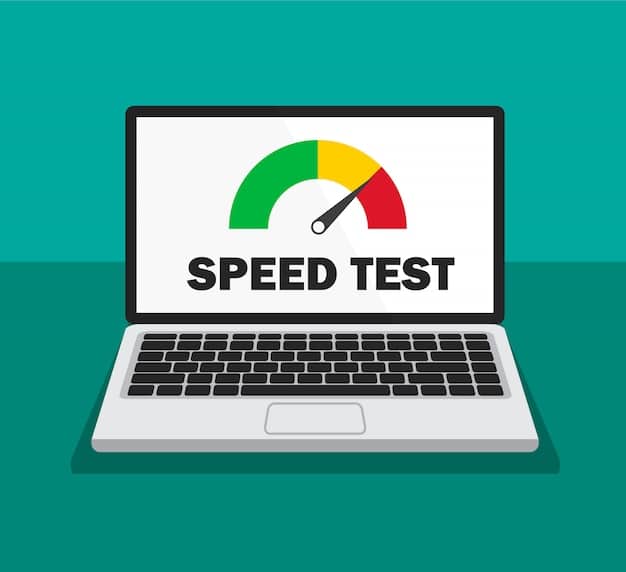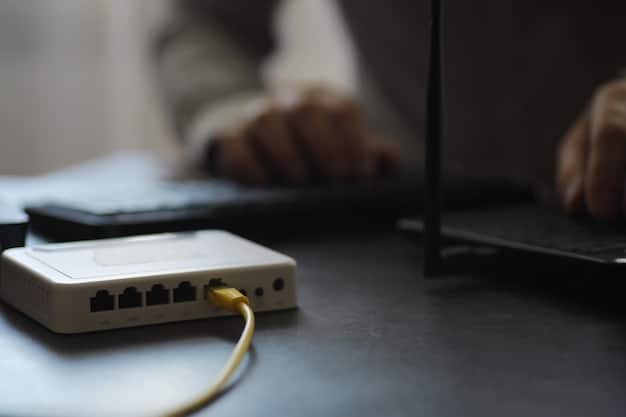Is Your Streaming Quality Suffering? Tips for US Asian Drama Viewers

Is your streaming quality suffering while trying to enjoy Asian dramas? This guide provides troubleshooting tips for US viewers to diagnose and fix common streaming issues, ensuring a smooth viewing experience.
Are you experiencing pixelated images, buffering, or frequent interruptions while streaming your favorite Asian dramas? Don’t let technical difficulties ruin your viewing pleasure. Let’s explore some common issues and troubleshooting tips tailored for US viewers of Asian dramas.
Understanding Streaming Quality Issues
Before diving into troubleshooting, it’s crucial to understand what factors can influence your streaming quality. Several elements, ranging from your internet speed to the streaming service’s server load, can contribute to a less-than-ideal viewing experience. By identifying these factors, you can start to pinpoint the root cause of your streaming problems.
Internet Speed and Bandwidth
Your internet speed is a primary determinant of streaming quality. Insufficient bandwidth can lead to buffering, pixelation, and interruptions. Streaming services recommend minimum speeds for various resolutions.
Streaming Service Servers
The streaming service’s servers also play a vital role. Overloaded or poorly maintained servers can result in streaming issues, even if your internet connection is strong. Service outages can also occur, preventing you from streaming at all.
Here are the two steps you can take to improve your streaming:
- Check your internet speed using a reliable online speed test.
- Monitor server status updates from your streaming provider.
Understanding the interplay between internet speed and server performance is the first step in resolving streaming quality issues. Once you know where the problem lies, you can implement targeted solutions.

Diagnosing Common Streaming Problems
Once you understand the potential causes, it’s time to diagnose the specific streaming issues you’re experiencing. Common problems include buffering, pixelation, audio issues, and error messages. Each of these symptoms points to different underlying causes, which require different troubleshooting approaches.
Buffering and Loading Issues
Buffering occurs when your device doesn’t receive data fast enough to play the video in real-time. Slow internet speeds, network congestion, or server issues can cause this. Frequent loading screens are another symptom of this problem.
Pixelation and Blurry Images
Pixelation happens when the video resolution is reduced due to insufficient bandwidth. This results in blurry or blocky images, making the viewing experience less enjoyable. It’s a common issue when streaming in lower resolutions.
Audio and Video Desync
Sometimes, the audio and video can become out of sync, creating a distracting viewing experience. This can be caused by device issues, streaming service glitches, or problems with your internet connection.
Use this check list to spot and troubleshoot streaming problems:
- Keep an eye on the video itself: look for pixelation, buffering, or synchronization issues.
- Listen closely to the audio: is it clear, or is it distorted or out of sync?
- Check for error messages or codes: these often provide clues about the cause of the problem.
Properly diagnosing streaming problems involves careful observation and a systematic approach. By understanding the symptoms, you can identify the underlying cause and implement the appropriate solutions.
Basic Troubleshooting Steps
Before delving into more complex solutions, it’s essential to try some basic troubleshooting steps. These simple fixes can often resolve common streaming issues quickly. Restarting devices, checking connections, and updating software are good starting points. These actions help ensure that your equipment and network are functioning optimally for streaming.
Restarting Devices
A simple restart can often resolve temporary glitches. Restart your streaming device (smart TV, Roku, Chromecast, etc.), modem, and router. This clears the memory and resets network connections.
Checking Physical Connections
Ensure all cables are securely connected. Loose or damaged cables can cause intermittent connectivity issues. Check the Ethernet cable (if applicable) and power cords.
Updating Software and Apps
Outdated software can cause compatibility issues. Update your streaming device’s operating system, streaming apps, and web browser. This ensures you have the latest bug fixes and performance improvements.
Here are some actions you can take:
- Unplug your modem and router, wait 30 seconds, and plug them back in.
- Ensure all cables are securely connected to your streaming device.
- Check for software updates on your streaming device and within your streaming apps.
Basic troubleshooting steps are a simple and effective way to address many common streaming issues. By performing these checks regularly, you can avoid many of the technical hiccups that disrupt your viewing experience.

Advanced Troubleshooting Techniques
If basic troubleshooting doesn’t solve the problem, it’s time to move on to more advanced techniques. Adjusting video quality settings, clearing cache and cookies, and optimizing your network settings can significantly improve your streaming experience. These steps help ensure that your device and network are configured to handle the demands of streaming high-quality video.
Adjusting Video Quality Settings
Lowering the video quality can reduce bandwidth consumption. Most streaming services allow you to adjust the resolution. Choose a lower setting (e.g., 720p instead of 1080p) to reduce buffering on slower connections.
Clearing Cache and Cookies
Over time, cached data and cookies can accumulate and cause performance issues. Clear the cache and cookies in your web browser or streaming app. This removes temporary files that may be interfering with streaming.
Optimizing Network Settings
Adjusting your network settings can improve streaming performance. Use a wired Ethernet connection instead of Wi-Fi for a more stable connection. Also, consider using a 5 GHz Wi-Fi band, which typically offers faster speeds and less interference than the 2.4 GHz band.
Some advanced step to take:
- Access the settings menu within your streaming app and select a lower video quality.
- Refer to your device’s or app’s settings to clear the cache and cookies.
- Check your router’s settings to switch to the 5 GHz Wi-Fi band if available.
Advanced troubleshooting techniques can fine-tune your streaming setup for optimal performance. By adjusting video settings, clearing unnecessary data, and optimizing network configurations, you can minimize disruptions and enjoy smoother streaming.
Specific Tips for Asian Drama Streaming Services
Each streaming service has its own set of quirks and optimal configurations. Understanding the specific settings and troubleshooting steps for popular Asian drama streaming platforms like Viki, Netflix, and Crunchyroll can enhance your viewing experience. Many services offer built-in diagnostics and troubleshooting tools that can help identify and resolve common issues. By familiarizing yourself with these platforms’ specific features, you can customize your setup to minimize streaming problems.
Viki
Viki is known for its user-generated subtitles. If you’re experiencing subtitle issues, try a different subtitle track or report the problem to Viki’s community. Also, ensure your browser or app is up to date for the best performance.
Netflix
Netflix offers various playback settings. Adjust your data usage settings to balance video quality and bandwidth consumption. You can also use Netflix’s built-in diagnostics tool to check your connection speed.
Crunchyroll
Crunchyroll is a popular platform for anime and Asian dramas. Ensure you have a stable internet connection and that your Crunchyroll app is updated to the latest version. Clear the app’s cache if you experience buffering issues.
In short, these are some specific considerations:
- Adjust your playback settings within Viki, Netflix, or Crunchyroll.
- Access the built-in speed test or diagnostics tool to check your connection speed.
- Check if the platform has a known issue that may be addressed in the platform’s FAQ.
Specific tips tailored for each streaming service can help optimize your viewing experience. By understanding the unique features and settings of Viki, Netflix, Crunchyroll, and other platforms, you can effectively troubleshoot common issues and enjoy your favorite Asian dramas without interruption.
When to Contact Support
Sometimes, despite your best efforts, streaming issues persist. Knowing when to contact customer support for your streaming service or internet provider is crucial. Customer support can provide specialized assistance and resolve problems beyond your capabilities. Recognizing the limits of your own troubleshooting and seeking professional help ensures that you receive the necessary support to restore your streaming quality.
Identifying Persistent Issues
If you’ve tried all the troubleshooting steps and the problem continues, it may be time to seek help. Persistent buffering, frequent error messages, or consistent audio/video desync issues indicate a deeper problem.
Gathering Information
Before contacting support, gather relevant information. Note the error messages you’re seeing, the time the issue occurred, and the steps you’ve already taken. This helps support staff diagnose the problem more efficiently.
Contacting the Right Support Channel
Determine whether the problem lies with your streaming service or internet provider. Contact their respective support channels for assistance. Many providers offer online chat, email, or phone support.
Key considerations when contacting customer support:
- Document the steps that you performed and the respective results.
- Check if there is a known outage of the streaming service or of your internet provider.
- Reach out to your internet provider in the event you are not getting the speed agreed upon.
Knowing when to contact support ensures that you receive expert assistance for complex streaming problems. By identifying persistent issues, gathering relevant information, and contacting the appropriate support channel, you can efficiently resolve problems and restore your viewing experience.
| Key Point | Brief Description |
|---|---|
| 📶 Check Internet Speed | Ensure your internet meets the minimum requirements for streaming quality. |
| 🔄 Restart Devices | Restart your streaming device, modem, and router to resolve temporary glitches. |
| ⚙️ Adjust Video Quality | Lower the video resolution to reduce buffering on slower connections. |
| 📞 Contact Support | Reach out to your streaming service or internet provider for persistent issues that can’t be resolved. |
Frequently Asked Questions
▼
Buffering often occurs due to slow internet speed, network congestion, or issues with the streaming service’s servers. Check your internet speed and consider lowering the video quality.
▼
The process varies by device. On most smart TVs or streaming boxes, you can find the option in the settings menu under apps or storage. Refer to your device’s manual for specific instructions.
▼
Ethernet is generally more stable and faster than Wi-Fi. If possible, connect your streaming device directly to your router using an Ethernet cable for a more reliable connection.
▼
Ensure your router is in a central, open location, away from obstructions & interference. Use a Wi-Fi extender to boost the signal if necessary. Consider switching to the 5 GHz band.
▼
Audio desync can result from device issues, streaming service glitches, or internet problems. Restarting your device or clearing the app’s cache can often resolve this. Check your internet stability as well.
Conclusion
Experiencing streaming issues while watching Asian dramas can be frustrating, but with the correct troubleshooting steps, you can often resolve these problems and get back to enjoying your favorite shows. Remember to check your internet connection, restart your devices, adjust video quality settings, and seek support when needed. Happy drama watching!





